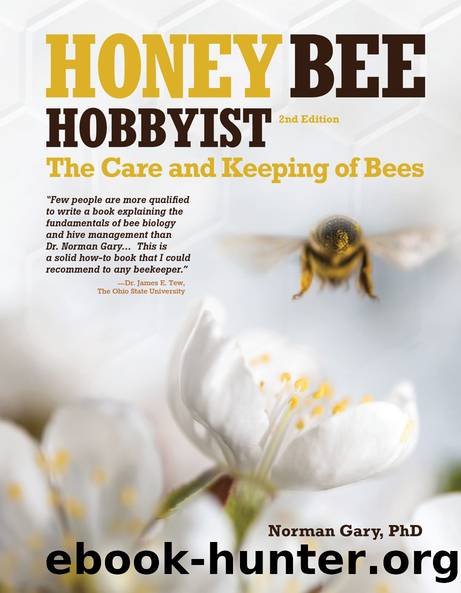Honey Bee Hobbyist by Norman Gary

Author:Norman Gary [Gary;, Norman PhD]
Language: eng
Format: epub
Tags: The Care and Keeping of Bees
Publisher: CompanionHouse Books
Published: 2019-01-15T14:57:44+00:00
Large populations greatly enhance the performance of colonies. Beekeepers would say this image depicts a strong colony because of the obvious high population density.
Food Stores
At least 10 pounds (4.5 kg) of reserve honey—the equivalent of about two deep frames of honey—should be in the hive at all times. Maintaining minimum honey reserves during the active foraging season is not usually a problem for the hobby beekeeper. The greatest risk of starvation is during intensive brood-rearing in early spring before nectar sources are available. A greedy beekeeper who harvests too much honey at one time can create another potential starvation risk. Harvesting all of the honey at once is especially risky when an anticipated postharvest honey flow doesn’t materialize because of bad weather, drought, or other factors. You can rescue a starving colony by feeding sugar syrup.
Pollen reserves are more difficult to evaluate. You should be able to see dozens of pollen-containing cells in the brood chamber. Pollen deficiency is a greater risk when large apiaries—perhaps fifty hives or more under commercial conditions—are seriously competing for limited pollen sources. Hobby beekeepers’ colonies are beginning to experience similar pollen-deficiency problems. There typically is a greater diversity of pollen sources in urban environments, but the increasing population of urban hobby beekeepers is greatly reducing the available pollen needed for healthy colonies. You can feed manufactured pollen substitutes when necessary, but natural pollen is more nutritious.
Worker Bee Population
Experience will teach you how to recognize normal colony populations as they fluctuate during the year. Two pounds (a little less than 1 kg) of bees (approximately 8,000 bees) in your first hive may seem like a lot to you, but just wait until you have 40,000 bees in the hive several months later.
How can you be sure that your hives have normal populations? If you’ve managed the hives identically, and one hive is twice as populous as the other, then you can look for problems in the “weak” colony. The most frequent cause of a weak colony is a poorly performing queen. Maybe she is old and has lost her vigor. Simply replace the queen and see what happens (see Queen Replacement and Introduction later in this chapter). Maybe you’ll get a much better queen and restore the colony population.
Adequate Comb Space
Good management for honey production requires adequate hive space to accommodate bee populations as well as the storage of surplus honey in amounts far beyond the bees’ nutritional needs. A hive may contain 100 pounds (45 kg) of honey—or even more—at one time. Large crops of honey cannot be produced unless you provide enough empty combs at the right time. Some beekeepers don’t harvest honey as often as they should. They just keep adding honey supers until the hives are as high as their heads. This is not recommended.
Feeding Sugar Syrup
Colonies can be fed ordinary table sugar (sucrose) dissolved in water to make a syrup. This is an excellent carbohydrate source that substitutes perfectly for honey. It is a highly refined natural product that is
Download
This site does not store any files on its server. We only index and link to content provided by other sites. Please contact the content providers to delete copyright contents if any and email us, we'll remove relevant links or contents immediately.
Sapiens: A Brief History of Humankind by Yuval Noah Harari(13036)
The Tidewater Tales by John Barth(12025)
Do No Harm Stories of Life, Death and Brain Surgery by Henry Marsh(6332)
Mastermind: How to Think Like Sherlock Holmes by Maria Konnikova(6220)
The Thirst by Nesbo Jo(5777)
Why We Sleep: Unlocking the Power of Sleep and Dreams by Matthew Walker(5636)
Sapiens by Yuval Noah Harari(4528)
Life 3.0: Being Human in the Age of Artificial Intelligence by Tegmark Max(4491)
The Longevity Diet by Valter Longo(4441)
The Rules Do Not Apply by Ariel Levy(3897)
The Immortal Life of Henrietta Lacks by Rebecca Skloot(3819)
The Body: A Guide for Occupants by Bill Bryson(3788)
Why We Sleep by Matthew Walker(3767)
Animal Frequency by Melissa Alvarez(3749)
Yoga Anatomy by Kaminoff Leslie(3696)
Barron's AP Biology by Goldberg M.S. Deborah T(3626)
The Hacking of the American Mind by Robert H. Lustig(3575)
All Creatures Great and Small by James Herriot(3506)
Yoga Anatomy by Leslie Kaminoff & Amy Matthews(3392)
